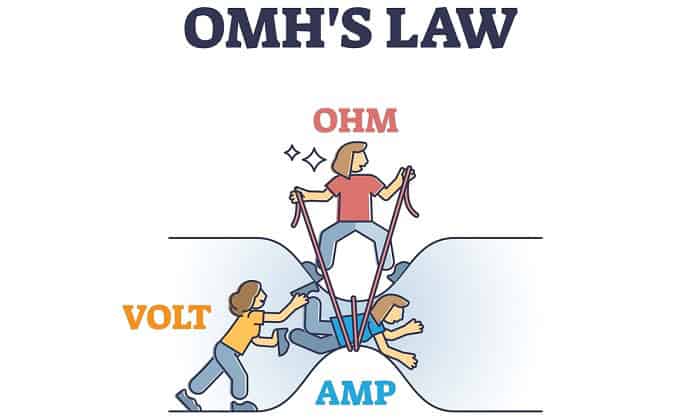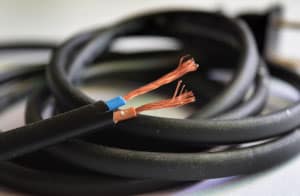10 gauge wire is commonly used for wiring 30 amp appliances like dryers and electric water heaters. To prevent any mishaps when plugging your appliances to 10 gauge wire, one factor you need to look at is the wire length.
How far can you run 10 gauge wire? 10 gauge copper wire can run 30 amps at 140 ⁰F up to 57 feet for 120 volts, and up to 114 feet for 240 volts. It can run lower currents farther.
Table of Contents
Maximum Length for 10 Gauge Wire at Different Currents
We’ve made a table that shows the maximum distances you can run 10 gauge wire at 140 ⁰F with a power factor of 0.9. The length is based on the current flowing through the wire at 120 volts and 240 volts and the values are rounded down to the nearest foot:
| Current | Copper wire length at 140 ⁰F | |
| For 120V | For 240V | |
| 15 amps | 114 ft | 229 ft |
| 20 amps | 85 ft | 171 ft |
| 25 amps | 68 ft | 137 ft |
| 30 amps | 57 ft | 114 ft |
The table shows the wire length for 15 amp and 20 amp household circuits. It also shows the length for 30 amps (the maximum amp rating for 10 gauge copper wire).
10 gauge copper wire can carry 30 amps up to 57 feet for 120 volts, and up to 114 feet for 240 volts.
Maximum Length for Types of 10 Gauge Cables
10 gauge multiconductor cables will have approximately the same maximum running length as a single conductor.
This means that the maximum length you can run 10/2 wire or 10/3 wire for 30 amps at 120 volts may still be around 57 feet, and at 240 volts will be 114 feet.
Take note that this will not be true for thicker wire gauges.
Calculation of the Distance Limit of 10 Gauge Wire
A convenient way to approximate the maximum length is to use an online calculator. These online websites can allow you to configure your results based on your specific requirements.
For example, if you need the length of 10 gauge wire for 220V circuits, an online calculator can easily provide you with a result.
A crude estimate some people do is to assume the behavior of single phase AC as DC and use the available data in the US National Electric Code Chapter 9 Table 9 for impedance instead of resistance. The wire length in this assumption can be derived from voltage drop:
- Voltage Drop Calculation (Single-phase system)
Z = Impedance of the conductor (ohms per 1,000 feet, or ohms / kft)
I = Current amps (A)
L = Length (ft)
\[ V_{\text{drop}} = \frac{2 \cdot Z \cdot I \cdot L}{1000 \, \text{ft}} \]
\[ \text{Length (feet)} = \frac{V_{\text{drop}} \cdot 1000 \, \text{ft}}{2 \cdot I \cdot Z} \]
and
\[ \text{Voltage Drop (Vdrop)} = \frac{V_{\text{drop}\%} \cdot \text{Source Voltage}}{100\%} \]
Let us try to estimate how long we can run 10 gauge wire on a 20 amp circuit at 120 volts using this method. We first get the actual voltage drop from a 120 volt source if we are limit the voltage drop to 3%:
\[ V_{\text{drop}} = \frac{3\% \cdot 120 \, \text{V}}{100\%} = 3.36 \, \text{V} \]
Then we get impedance from Chapter 9, Table 9 from the NEC. The impedance of 10 gauge wire at 0.85 power factor would be 1.1 ohms per 1000 sq. ft. So:
\[ \text{Length (feet)} = \frac{3.6V \cdot 1000 \, \text{ft}}{2 \cdot 20 \, \text{A} \cdot 1.1 \, \Omega} = 82 \, \text{feet} \]
You can also try using this equation if you want to know how long you can run 10 gauge wire from the combined feeder and branch circuit. This can help you estimate the length of wire on a 20 amp breaker within the 5% recommended voltage drop.
This estimate using this method is quite close to our value of 85 feet (within ±5%). Although this method is quick and conservative, several factors have been eliminated to get the true length.
The actual calculation involves adjusting power factors of impedance values and accounting for temperature’s effect on resistance before voltage drop could be computed.
In reality, calculating the maximum length can be tedious if you are not an electrician or an engineer. We suggest you refer to our table for convenience or use an online calculator for very specific needs like a different 10 AWG ampacity.
Factors Affecting the Distance Limit of 10 Gauge Wire
Voltage drop is the primary reason to limit the length of 10 gauge wire. It is a voltage decrease that occurs due to the internal resistance of the wire. This affects the performance of the equipment plugged into the circuit.
The greater the resistance of the wire, the larger the voltage drop. Some of the factors that affect the resistance of the wire would be:
1. Wire material
A more conductive wire material can cause smaller voltage drops. Copper is a more conductive material than aluminum, so copper will have lesser voltage drops for the same wire thickness and length than aluminum.
2. Current flowing through the wire
A larger current causes larger voltage drops. Our table shows that 10 gauge wire can be longer on a 25 amp circuit than on a 30 amp one.
3. Wire length
A longer wire can cause larger voltage drops. The additional wire length increases the resistance since the current must travel farther.
4. Wire diameter
A thicker wire can cause smaller voltage drops. Sizes larger than 10 gauge wire can allow more current to pass through a given length.
5. Wire temperature
The temperature of a wire may cause smaller or larger voltage drops for varied materials. For copper and aluminum in normal situations, a higher temperature causes a higher resistance.
Practical Limitations to Consider
The US National Electric Code (or NEC) recommends a voltage drop not greater than 3% for branch circuits, and not greater than 5% for feeder and branch circuits combined.
Most states accept this recommendation, so check your local codes first before buying wires. Take note that this recommendation is more on improving the performance of plugged devices rather than a safety issue.
Our table ensures that the length of 10 gauge wire does not exceed the 3% voltage drop in a branch circuit on a 15 amp circuit up to a 30 amp circuit on household conditions. Of course, this may change for commercial settings using three phase circuits or have different uses like higher temperatures.
Conclusion
10 gauge wire can run up to 57 feet at 30 amps, but lower current ratings can have longer wires.
Also, how far can you run 10 gauge wire will always depend on the voltage drop of the wire, so the length will depend on some factors like wire material, current, and temperature among others. So always check the wire length to ensure your distant equipment will get enough electricity to perform its functions.

I am Edwin Jones, in charge of designing content for Galvinpower. I aspire to use my experiences in marketing to create reliable and necessary information to help our readers. It has been fun to work with Andrew and apply his incredible knowledge to our content.





